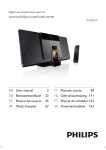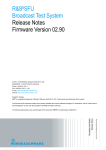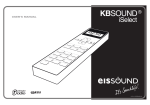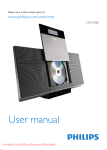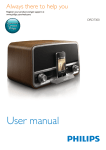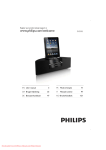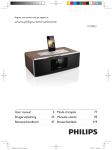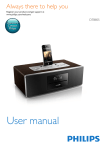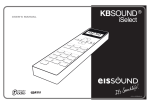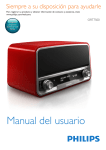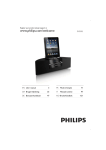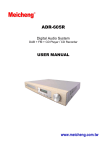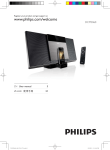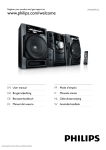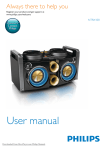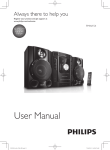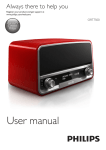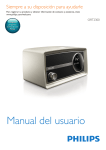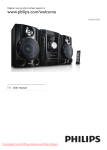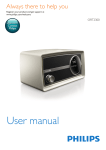Download Philips DCB3070 User Guide Manual
Transcript
Register your product and get support at www.philips.com/welcome EN User manual 3 DCB3070 IT Manuale utente 89 DEBenutzerhandbuch 23 NLGebruiksaanwijzing111 ES Manual del usuario 45 PT Manual do utilizador133 FR Mode d’emploi SVAnvändarhandbok 153 Downloaded From Disc-Player.com Philips Manuals 67 Important notes for users in the U.K. Mains fuse This information applies only to products with a UK mains plug. This product is fitted with an approved non-molded plug. If you replace the fuse, use one with: • the ratings shown on the plug, • a BS 1362 approval, and • the ASTA approval mark. Contact your dealer if you are not sure about what type of fuse to use. Caution: To conform with the EMC directive (2004/108/EC), do not detach the plug from the power cord. How to connect a plug The wires in the power cord are colored as follows: blue = neutral (N), brown = live (L). If the colors do not correspond with the colors on your plug, identify the terminals in your plug as follows: 1 2 3 Connect the blue wire to the terminal marked N or colored black. Connect the brown wire to the terminal marked L or colored red. Do not connect either wire to the earth terminal in the plug, marked E (or e) or colored green (or green and yellow). Before you replace the plug cover, make sure that the cord grip is clamped over the sheath of the cable and not just over the two wires in the cable. Downloaded From Disc-Player.com Philips Manuals 1Important 4 Safety 4 Notice5 2 Your product 7 Introduction7 What's in the box 7 Overview of the main unit 8 Overview of the remote control 9 3 Get started 10 Placement10 Prepare the remote control 10 Connect power 11 Store DAB stations 11 Set clock 11 Turn on 12 4Play 12 5 Adjust sound 14 6 Listen to radio 14 Play disc Play from USB Pause/resume play Skip to a track Search within a track Display play information Repeat and shuffle play Program tracks Adjust volume Select a preset sound effect Enhance bass Mute sound Listen to DAB radio Listen to FM radio 7 Play iPod/iPhone/iPad 17 8 Other features 18 9 Product information 19 10Troubleshooting 20 Compatible iPod/iPhone/iPad Load the iPod/iPhone/iPad Listen to the iPod/iPhone/iPad Charge the iPod/iPhone/iPad 17 17 17 17 Set the alarm timer Set the sleep timer Play from an external device Headphone 18 18 18 18 Specifications USB playability information Supported MP3 disc formats Maintenance 19 19 20 20 12 12 12 13 13 13 13 13 14 14 14 14 14 16 EN Downloaded From Disc-Player.com Philips Manuals 3 English Contents 1Important Safety f Clean only with dry cloth. g Do not block any ventilation openings. Install in accordance with the manufacturer's instructions. h Do not install near any heat sources such as radiators, heat registers, stoves, or other apparatus (including amplifiers) that produce heat. i Protect the power cord from being walked on or pinched, particularly at plugs, convenience receptacles, and the point where they exit from the apparatus. j Only use attachments/accessories specified by the manufacturer. This 'bolt of lightning' indicates uninsulated material within your unit may cause an electrical shock. For the safety of everyone in your household, please do not remove product covering. The 'exclamation point' calls attention to features for which you should read the enclosed literature closely to prevent operating and maintenance problems. WARNING: To reduce the risk of fire or electric shock, this apparatus should not be exposed to rain or moisture and objects filled with liquids, such as vases, should not be placed on this apparatus. CAUTION: To prevent electric shock, match wide blade of plug to wide slot, fully insert. Important Safety Instructions a Read these instructions. b Keep these instructions. c Heed all warnings. d Follow all instructions. e Do not use this apparatus near water. 4 EN Downloaded From Disc-Player.com Philips Manuals k Use only with the cart, stand, tripod, bracket, or table specified by the manufacturer or sold with the apparatus. When a cart is used, use caution when moving the cart/apparatus combination to avoid injury from tip-over. l Unplug this apparatus during lightning storms or when unused for long periods of time. m Refer all servicing to qualified service personnel. Servicing is required when the apparatus has been damaged in any way, such as power-supply cord or plug is damaged, liquid has been spilled or objects have fallen into the apparatus, the apparatus has been exposed to rain or moisture, does not operate normally, or has been dropped. n Battery usage CAUTION – To prevent battery leakage which may result in bodily injury, property damage, or damage to the unit: • Install all batteries correctly, + and - as marked on the unit. • Do not mix batteries (old and new or carbon and alkaline, etc.). o Apparatus shall not be exposed to dripping or splashing. p Do not place any sources of danger on the apparatus (e.g. liquid filled objects, lighted candles). q Where the MAINS plug or an appliance coupler is used as the disconnect device, the disconnect device shall remain readily operable. Warning •• Never remove the casing of this apparatus. •• Never lubricate any part of this apparatus. •• Never place this apparatus on other electrical equipment. •• Keep this apparatus away from direct sunlight, naked flames or heat. •• Never look into the laser beam inside this apparatus. •• Ensure that you always have easy access to the power cord, plug or adaptor to disconnect this apparatus from the power. Note •• The type plate is located at the rear of the apparatus. • Sound can be deceiving. Over time your hearing 'comfort level' adapts to higher volumes of sound. So after prolonged listening, what sounds 'normal' can actually be loud and harmful to your hearing. To guard against this, set your volume to a safe level before your hearing adapts and leave it there. To establish a safe volume level: • Set your volume control at a low setting. • Slowly increase the sound until you can hear it comfortably and clearly, without distortion. Listen for reasonable periods of time: • Prolonged exposure to sound, even at normally 'safe' levels, can also cause hearing loss. • Be sure to use your equipment reasonably and take appropriate breaks. Be sure to observe the following guidelines when using your headphones. • Listen at reasonable volumes for reasonable periods of time. • Be careful not to adjust the volume as your hearing adapts. • Do not turn up the volume so high that you can't hear what's around you. • You should use caution or temporarily discontinue use in potentially hazardous situations. Do not use headphones while operating a motorized vehicle, cycling, skateboarding, etc.; it may create a traffic hazard and is illegal in many areas. Hearing safety Listen at a moderate volume. • Using headphones at a high volume can impair your hearing. This product can produce sounds in decibel ranges that may cause hearing loss for a normal person, even for exposure less than a minute. The higher decibel ranges are offered for those that may have already experienced some hearing loss. Notice Any changes or modifications made to this device that are not expressly approved by Philips Consumer Lifestyle may void the user’s authority to operate the equipment. EN Downloaded From Disc-Player.com Philips Manuals 5 English • Remove batteries when the unit is not used for a long time. • Batteries (battery pack or batteries installed) shall not be exposed to excessive heat such as sunshine, fire or the like. This product complies with the radio interference requirements of the European Community. Your product is designed and manufactured with high quality materials and components, which can be recycled and reused. When this crossed-out wheeled bin symbol is attached to a product it means that the product is covered by the European Directive 2002/96/ EC. Please inform yourself about the local separate collection system for electrical and electronic products. Please act according to your local rules and do not dispose of your old products with your normal household waste. Correct disposal of your old product helps to prevent potential negative consequences for the environment and human health. Your product contains batteries covered by the European Directive 2006/66/EC, which cannot be disposed with normal household waste.Please inform yourself about the local rules on separate collection of batteries because correct disposal helps to prevent negative consequences for the environmental and human health. Environmental information All unnecessary packaging has been omitted. We have tried to make the packaging easy to separate into three materials: cardboard (box), 6 EN Downloaded From Disc-Player.com Philips Manuals polystyrene foam (buffer) and polyethylene (bags, protective foam sheet.) Your system consists of materials which can be recycled and reused if disassembled by a specialized company. Please observe the local regulations regarding the disposal of packaging materials, exhausted batteries and old equipment. The making of unauthorized copies of copyprotected material, including computer programs, files, broadcasts and sound recordings, may be an infringement of copyrights and constitute a criminal offence. This equipment should not be used for such purposes. “Made for iPod,” “Made for iPhone,” and “Made for iPad” mean that an electronic accessory has been designed to connect specifically to iPod, iPhone, or iPad, respectively, and has been certified by the developer to meet Apple performance standards. Apple is not responsible for the operation of this device or its compliance with safety and regulatory standards. Please note that the use of this accessory with iPod, iPhone, or iPad may affect wireless performance. iPad, iPhone, iPod, iPod nano, and iPod touch are trademarks of Apple Inc., registered in the U.S. and other countries. Windows Media and the Windows logo are trademarks, or registered trademarks of Microsoft Corporation in the United States and/or other countries. 2 Your product Congratulations on your purchase, and welcome to Philips! To fully benefit from the support that Philips offers, register your product at www.philips.com/welcome. Introduction With this unit, you can enjoy audio from discs, iPod/iPhone/iPad, USB devices, and other external devices, or listen to radio stations. The unit offers Digital Sound Control (DSC) and Dynamic Bass Boost (DBB) to enrich sound. The unit supports the following media formats: What's in the box Check and identify the contents of your package: • Main unit • Remote control • 2 x AAA batteries • AC power cable • 1 x MP3 link cable • Quick start guide • User manual • Wall mounting instructions • Mounting kit (2 dowels and 2 screws) EN Downloaded From Disc-Player.com Philips Manuals 7 English This apparatus includes this label: Overview of the main unit l m n M 3 L NK h i d e f g j o p k a • Turn on the unit, switch to standby mode, or switch to Eco Power standby. b SOURCE • Select a source: CD, DAB radio, FM radio, iPod/iPhone/iPad, USB, or MP3 link. c d e / • Skip to the previous/next track. • Search within a track. • Tune to a radio station. /OK • Start or pause play. • Confirm a selection. • For FM radio, select stereo or mono sound output. /MENU • Stop play. • Access the iPod/iPhone menu, or the DAB menu. f VOLUME + / • Adjust volume. g • Open/close the disc compartment. 8 EN Downloaded From Disc-Player.com Philips Manuals h Display panel • Show current status. i Disc compartment door j Dock for iPod/iPhone/iPad k Remote sensor • Detect signal from the remote control. l m • Connector for a headphone. • Connector for a USB mass storage device. n MP3 LINK • Connector (3.5mm ) for an external audio device. o FM antenna • Improve FM reception. p AC MAINS • Connector for the AC power cable. b d b DAB CD FM PRESET/A BUM s r q OK d MP 3 LINK e DOCK USB p o RDS g h VOL 2 3 4 5 6 7 8 9 j PROG/ CLOCK SET 0 MODE/ SCAN n k SLEEP/ TIMER DSC DBB m l f RDS/DISPLAY • Select RDS broadcast information. • Select display information during play. • Start or pause play. • For FM radio, select stereo or mono sound output. h VOL +/• Adjust volume. 1 i / • Skip to the previous/next track. • Search within a track. • Tune to a radio station. e USB/MP3 LINK • Select USB device source. • Select external audio device source. g MENU DISPLAY f • Mute or restore volume. c CD • Select disc source. a c • Turn on the unit, switch to standby mode, or switch to Eco Power standby. i Numeric keypad • Select a track from a disc directly. j PROG/CLOCK SET • Program radio stations. • Set the clock. • Program tracks. k SLEEP/TIMER • Set the sleep timer. • Set the alarm timer. l DSC • Select a preset sound setting. m DBB • Turn dynamic bass enhancement on or off. n MODE/SCAN • Select repeat/shuffle play. EN Downloaded From Disc-Player.com Philips Manuals 9 English a Overview of the remote control • Search and store DAB/FM radio stations. o /MENU • Stop play. • Access the iPod/iPhone menu, or the DAB menu. 3 Get started Caution •• Use of controls or adjustments or performance of procedures other than herein may result in hazardous radiation exposure or other unsafe operation. p DOCK • Select iPod/iPhone/iPad source. q OK • Confirm a selection. r PRESET/ALBUM / • Skip to the previous/next album. • Select a preset radio station. • Navigate the iPod/iPhone/iPad menu. s FM/DAB • Select FM or DAB radio source. Always follow the instructions in this chapter in sequence. If you contact Philips, you will be asked for the model and serial number of this apparatus. The model number and serial number are on the rear of the apparatus. Write the numbers here: Model No. __________________________ Serial No. ___________________________ Placement You can place the unit on a flat surface or mount the unit on a wall. Mount on a wall To wall mount the unit, see the included separate sheet of wall mounting instructions. Prepare the remote control Caution •• Risk of explosion! Keep batteries away from heat, sunshine, or fire. Never discard batteries in fire. To insert the remote control battery: 1 2 3 10 EN Downloaded From Disc-Player.com Philips Manuals Open the battery compartment. Insert 2 AAA batteries with correct polarity (+/-) as indicated. Close the battery compartment. Press OK to start to search and store DAB stations. »» The unit stores all the available DAB stations. English 2 »» When all the available DAB stations are stored, the first stored DAB station is broadcast. Note •• If you are not going to use the remote control for a long time, remove the batteries. •• Do not use old and new or different types of batteries in combination. •• Batteries contain chemical substances, so they should be disposed of properly. Connect power Caution •• Risk of product damage! Make sure that the power supply voltage corresponds to the voltage printed on the rear of the main unit. •• Before connecting the AC cord, make sure that you have completed all other connections. Note Note •• Position the antenna as far as possible from TV, VCR, or other radiation source. •• For optimal reception, fully extend and adjust the position of the antenna. Set clock Note •• You can set the clock in standby mode only. 1 2 •• The type plate is located on the rear of the main unit. 1 Connect the AC power cable to: • the AC MAINS connector on the rear of the unit. • the wall socket. Store DAB stations When you connect AC power and no DAB stations are stored, the unit prompts you to search and store all the available DAB stations. 1 Connect the unit to the power supply. »» [FULL SCAN](full scan) is displayed. 3 4 5 6 7 8 Press to switch the unit to standby. • Make sure that --:-- (or clock) is displayed (see "Turn on" > "Switch to standby"). Press and hold PROG/CLOCK SET to activate the clock setting mode. »» SET CLOCK is displayed. »» The 12 hour or 24 hour format is displayed. Press / to select 12 hour or 24 hour format. Press PROG/CLOCK SET. »» The hour digits begin to blink. Press / to set the hour. Press PROG/CLOCK SET. »» The minute digits begin to blink. Press / to set the minute. Press PROG/CLOCK SET to confirm. EN Downloaded From Disc-Player.com Philips Manuals 11 Turn on 1 Press . »» The unit switches to the last selected source. Switch to standby 1 When the unit is turned on, press to switch the unit to standby. • In standby, press and hold to switch from normal standby to Eco power standby or vice versa. »» In normal standby, the clock (if set) appears on the display panel. 4Play Play disc 1 2 3 4 »» In Eco power standby, the backlight on the display panel turns off. Press CD to select the disc source. Press on the unit to open the disc compartment. Insert a disc with the printed side facing outward, and then press to close the disc compartment. If the disc doesn't play, press • To stop play, press . . Play from USB Note •• Make sure that the USB storage device contains playable audio content. 1 2 Connect the USB storage device into the connector on the back panel of this unit. Press USB to select the USB source. »» Play starts automatically. • • • • To select a folder, press . To select an audio file, press To start play, press . To stop play, press . / Pause/resume play 1 12 EN Downloaded From Disc-Player.com Philips Manuals During play, press play. to pause/resume . Skip to a track Tip are played. For CD: 1 Press / to select another track. • To select a track directly, you can also press a key on the numerical keypad. For MP3 disc and USB: 1 2 Press Press or file. to select an album or folder. / to select previous/next track Search within a track 1 2 During play, press and hold / . Release to resume normal play. Display play information 1 During play, press DISPLAY repeatedly to select different play information. Repeat and shuffle play 1 2 English •• Shuffle play is not available when programmed tracks Program tracks You can program a maximum of 20 tracks. 1 2 3 4 5 In CD/USB mode, in the stop position, press PROG/CLOCK SET to activate the program mode. »» [PROG] (program) and track number begin to blink. For MP3 tracks, press album. to select an Press / to select a track number, then press PROG/CLOCK SET to confirm. Repeat steps 2 to 3 to program more tracks. Press to play the programmed tracks. »» During play, [PROG] (program) is displayed. • To erase the program, in the stop position, press . »» [PROG] disappears on the display. During play, press MODE/SCAN repeatedly to select a play option. • : the current track is played repeatedly. • : all the tracks are played repeatedly. • : all tracks are played in a random order. To return to normal play, press MODE/ SCAN repeatedly until no repeat/shuffle option is displayed. • You may also press to cancel repeat/ shuffle play. EN Downloaded From Disc-Player.com Philips Manuals 13 5 Adjust sound 6 Listen to radio Adjust volume Listen to DAB radio 1 DAB (Digital Audio Broadcasting) radio broadcasts radio digitally through a network of transmitters. During play, press VOL +/- to increase/ decrease the volume. Select a preset sound effect Store DAB stations 1 Before you can listen to DAB radio, store DAB stations onto the unit. If you connect the unit to AC power supply and no DAB station is stored, the unit prompts you to search and store all the available DAB stations (see "Get started" > "Store DAB stations"). Or During play, press DSC repeatedly to select a preset sound setting. Enhance bass 1 During play, press DBB to turn dynamic bass enhancement on or off. »» If DBB is activated, DBB is displayed. 1 2 During play, press speakers. Press MODE/SCAN. »» The unit begins to perform a search. »» When all the available DAB stations are stored, the first stored DAB station is broadcast. Mute sound 1 Press FM/DAB to turn on DAB radio. to mute/restore the Tip •• The signal icon (*) is displayed, and its position indicates a degree of signal strength. The further towards the right, the stronger the signal strength. •• If no DAB coverage is currently available or no DAB station is found, [NO DAB] (no DAB) is displayed. Tune to a DAB station After DAB stations are stored, you can tune to a DAB station. 1 14 EN Downloaded From Disc-Player.com Philips Manuals In DAB mode, press / repeatedly until a station name is displayed. Press OK to confirm the selection. »» The radio immediately tunes to the selected station. Use the DAB menu 1 2 Note •• Position the antenna as far as possible from TV, VCR, or other radiation source. •• For optimal reception, fully extend and adjust the position of the antenna. Program DAB stations manually You can program a maximum of 20 preset DAB stations. 1 2 3 4 Tune to a DAB station. Press PROG/CLOCK SET to activate program mode. Press to allocate a number (1-20) to this radio station, and then press PROG/ CLOCK SET to confirm. Repeat the above steps to program other stations. Note •• If a DAB station is stored under a preset location, a new DAB station assigned to this location overwrites the old DAB station. •• DAB station presets do not overwrite FM presets. Select a preset DAB station After the DAB stations are programmed on the unit, you can select a preset DAB station. 1 In DAB mode, press preset number. to select a Display DAB information In DAB mode, you may press RDS/DISPLAY repeatedly to select different information for the current DAB station. 3 4 In DAB mode, press MENU. »» The first menu option is displayed. Press / repeatedly to display the menu options: • [FULL SCAN] (full scan): search and store all the available DAB stations. • [MANUAL] (manual): manually tune to a DAB station. • [DRC]: add or remove a degree of compensation for differences in the dynamic range between DAB stations. You may experiment with the options on different source materials to decide which option suits best. • [SYSTEM] (system): reset all DAB settings to the default settings made at the factory; display the software version of this unit; enter a stage of software upgrade. • [STATION] (station): display a list of available DAB stations. Press OK to confirm the selection. If a sub-option is available, repeat step 2 and step 3. Update software (if available) Software update for your radio may be available in future. How to know a software update: • register this unit at Philips website (www.philips.com/welcome) with a valid email address, and you may receive software update notification if available. Or, • visit Philips website constantly to check if the updating information is provided. To update software of your radio, follow these steps strictly: 1 Read carefully the software update instructions on Philips website. EN Downloaded From Disc-Player.com Philips Manuals English 2 15 2 3 4 5 Download the software update to your PC, and then connect the unit to the PC via the USB connector. 1 In DAB mode, press MENU. Select [SYSTEM] (system) > [UPGRADE] (upgrade), and then follow the instructions displayed to go to the upgrade stage. • To select an option, press / ; to confirm a selection, press OK. On the PC, follow the instructions on the screen to complete upgrade. »» All available stations are programmed. »» The first programmed radio station is broadcast automatically. Program FM stations manually You can program a maximum of 20 preset FM stations. Listen to FM radio 1 2 Tune to a FM station 3 1 2 3 Press FM. Press and hold / for more than 2 seconds. »» [SEARCH] (search) is displayed. 4 »» The radio tunes to a station with strong reception automatically. Repeat step 2 to tune to more stations. • To tune to a weak station, press / repeatedly until you find optimal reception. • To achieve sound quality, press repeatedly to select stereo or mono sound. Note •• Position the antenna as far as possible from TV, VCR, or other radiation source. •• For optimal reception, fully extend and adjust the position of the antenna. Program FM stations automatically You can program a maximum of 20 preset FM stations. 16 EN Downloaded From Disc-Player.com Philips Manuals In FM mode, press and hold MODE/ SCAN for more than 2 seconds to activate automatic program mode. »» [AUTO] (auto) is displayed. Tune to a radio station. Press PROG/CLOCK SET to activate program mode. »» [PROG] (program) begins to blink. Press to allocate a number (1 to 20) to this radio station, and then press PROG/ CLOCK SET to confirm. Repeat the previous steps to program other stations. Note •• To overwrite a programmed FM station, store another FM station in its place. Select a preset FM station 1 In FM mode, press number. to select a preset FM stations with RDS Radio Data System (RDS) is a service that sends additional broadcast information along with FM stations. If you listen to a FM station with RDS signal, "RDS" is displayed. Display RDS information 1 For a FM station with RDS, press RDS repeatedly to display various broadcast information. Install the rubber pad English 7 Play iPod/ iPhone/iPad If necessary, install the supplied rubber pad to keep the iPad/iPad 2 stable before you place the iPad/iPad 2. You can enjoy audio from iPod/iPhone/iPad through this unit. Compatible iPod/iPhone/iPad The unit supports the following iPod, iPhone and iPad models. Made for: iPod touch (1st, 2nd, 3rd, and 4th generation) iPod nano (1st, 2nd, 3rd, 4th, 5th, and 6th generation) iPhone 4 iPhone 3GS iPhone 3G iPhone iPad 2 iPad Load the iPod/iPhone/iPad Listen to the iPod/iPhone/ iPad 1 2 3 Make sure that the iPod/iPhone/iPad is correctly placed. Press DOCK to select the iPod/iPhone/ iPad source. Play music on the iPod/iPhone/iPad. • To pause/resume play, press . • To skip to a track, press / . • To search during play, press and hold / , and then release to resume normal play. • To navigate the menu, press MENU, and press to select an option, and then press OK to confirm. Charge the iPod/iPhone/iPad 1 2 Push the dock compartment to open it. Place the iPod/iPhone/iPad in the dock. When the unit is connected to power, the docked iPod/iPhone/iPad begins to charge. Note •• The following iPod models cannot be charged: iPod classic, iPod with video, and iPod with color display. •• In Eco power standby mode, charge is not available. EN Downloaded From Disc-Player.com Philips Manuals 17 8 Other features Set the sleep timer This unit can switch to standby automatically after a set period of time. 1 Set the alarm timer This unit can be used as an alarm clock. The disc/radio/USB/docked product is activated to play at a preset time. 1 2 3 4 5 6 7 8 Make sure that you have set the clock correctly. To deactivate sleep timer 1 Press to switch the unit to standby. • Make sure that the clock is displayed (see "Turn on" > "Switch to standby"). Press SLEEP/TIMER repeatedly until [OFF] (off) is displayed. »» When sleep timer is deactivated, disappears on the display. Press and hold SLEEP/TIMER. »» A prompt to select the source is displayed. Play from an external device Press CD, FM, USB or DOCK to select a source. You can also listen to an external audio device through this unit. Press SLEEP/TIMER to confirm. »» The clock digits are displayed and begin to blink. Press / to set the hour. 1 2 Press SLEEP/TIMER to confirm. Press / to set the minute. »» The timer is set and activated. To deactivate or re-activate an alarm timer 1 2 When the unit is turned on, press SLEEP/ TIMER repeatedly to select a set period of time (in minutes). »» When sleep timer is activated, is displayed. Press 3 Press MP3 LINK to select the MP3 link source. Connect the supplied MP3 link cable to: • the MP3 LINK connector (3 5mm) on the unit. • the headphone connector on an external device. Start to play the device (see the device's user manual). to switch to standby mode. Press SLEEP/TIMER repeatedly to activate or deactivate timer. »» If timer is activated, the display shows . »» If timer is deactivated, the display. disappears on Note •• In MP3 link mode, the alarm timer cannot be set. •• If disc/USB/dock source is selected and the audio cannot be played, tuner is activated automatically. 18 EN Downloaded From Disc-Player.com Philips Manuals Headphone Plug headphones (not supplied) into the connector on the unit to listen through the headphones. Note •• Product information is subject to change without prior notice. Specifications Amplifier Rated Output Power Frequency Response Signal to Noise Ratio MP3 link input 2 x 20W RMS 60 Hz - 16 kHz, ±3 dB >65dBA 500mv, 20kohm Tuner Tuning Range Tuning grid FM sensitivity - Mono DAB sensitivity - (EN50248) Total Harmonic Distortion Signal to Noise Ratio Number of presets FM:87.5 - 108 MHz DAB:174.928MHz239.200MHz (Band III) 50 KHz 26 dB < -95 dBm <2% >55 dB 20 (FM) Speakers Speaker Impedance Speaker Driver Sensitivity 8 ohm 2 X 2.5" full range >82 dB/m/W General information AC power Operation Power Consumption Eco Standby Power Consumption USB Direct Dimensions - Main Unit (W x H x D) Weight - Main Unit AC 100-240V~, 50/60 Hz 32 W <1 W Version 2.0/1.1 500 x 217 x 98 mm 2.614 kg USB playability information Compatible USB storage devices: • USB flash memory (USB 2.0 or USB1.1) • USB flash players (USB 2.0 or USB1.1) • memory cards (requires an additional card reader to work with this system) Supported formats: • USB or memory file format FAT12, FAT16, FAT32 (sector size: 512 bytes) • MP3 bitrate (data rate): 32-320 Kbps and variable bitrate • Directory nesting up to a maximum of 8 levels • Number of albums/ folders: maximum 99 • Number of tracks/titles: maximum 999 • ID3 tag v2.0 or later • File name in Unicode UTF8 (maximum length: 128 bytes) Unsupported formats: • Empty albums: an empty album is an album that does not contain MP3 files, and is not shown in the display. • Unsupported file formats are skipped. For example, Word documents (.doc) or MP3 files with extension .dlf are ignored and not played. • AAC, WAV, PCM audio files EN Downloaded From Disc-Player.com Philips Manuals English 9Product information 19 • • DRM protected WMA files (*.wav, *.m4a, *.m4p, *.mp4, *.aac) WMA files in Lossless format Supported MP3 disc formats • • • • • ISO9660, Joliet Maximum title number: 999 (depending on file name length) Maximum album number: 99 Supported sampling frequencies: 32 kHz, 44.1kHz, 48 kHz Supported Bit-rates: 32~256 (kbps), variable bit rates Maintenance Clean the cabinet • Use a soft cloth slightly moistened with a mild detergent solution. Do not use a solution containing alcohol, spirits, ammonia or abrasives. Clean discs • When a disc becomes dirty, clean it with a cleaning cloth. Wipe the disc from the centre out. • Do not use solvents such as benzene, thinner, commercially available cleaners, or antistatic spray intended for analogue records. Clean the disc lens • After prolonged use, dirt or dust may accumulate at the disc lens. To ensure good play quality, clean the disc lens with Philips CD lens cleaner or any commercially available cleaner. Follow the instructions supplied with cleaner. 20 EN Downloaded From Disc-Player.com Philips Manuals 10Troubleshooting Warning •• Never remove the casing of this apparatus. To keep the warranty valid, never try to repair the system yourself. If you encounter problems when using this apparatus, check the following points before requesting service. If the problem remains unsolved, go to the Philips web site (www. philips.com/welcome). When you contact Philips, ensure that the apparatus is nearby and the model number and serial number are available. No power •• Ensure that the AC power plug of the unit is connected properly. •• Ensure that there is power at the AC outlet. •• To save power, the unit switches to standby automatically 15 minutes after a play reaches the end and no control is operated. No sound •• Adjust the volume. No response from the unit •• Disconnect and reconnect the AC power plug, then turn on the unit again. Remote control does not work •• Before pressing any function button, first select the correct source with the remote control instead of the main unit. •• Reduce the distance between the remote control and the unit. •• Insert the battery with its polarities (+/– signs) aligned as indicated. •• Replace the batteries. •• Aim the remote control directly at the sensor on the front of the unit. English No disc detected •• Insert a disc. •• Check if the disc is inserted with the print side facing inward. •• Wait until the moisture condensation at the lens has cleared. •• Replace or clean the disc. •• Use a finalized CD or correct format disc. Cannot display some files in USB device •• The number of folders or files in the USB device has exceeded a certain limit. This phenomenon is not a malfunction. •• The formats of these files are not supported. USB device not supported •• The USB device is incompatible with the unit. Try another one. Poor radio reception •• Increase the distance between the unit and your TV or VCR. •• Fully extend and adjust the FM antenna. Timer does not work •• Set the clock correctly. •• Switch on the timer. Clock/timer setting erased •• Power has been interrupted or the power cord has been disconnected. •• Reset the clock/timer. EN Downloaded From Disc-Player.com Philips Manuals 21 Specifications are subject to change without notice © 2012 Koninklijke Philips Electronics N.V. All rights reserved. DCB3070_10_UM_V2.0 Downloaded From Disc-Player.com Philips Manuals






















